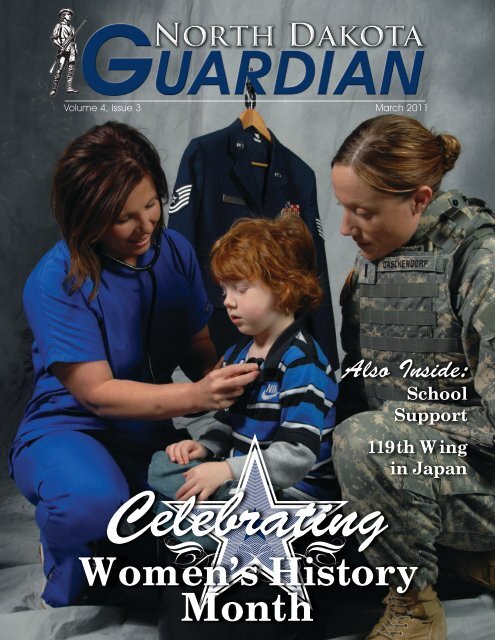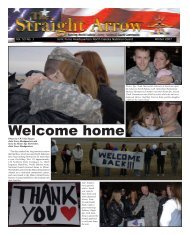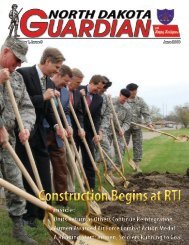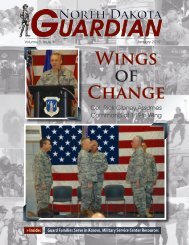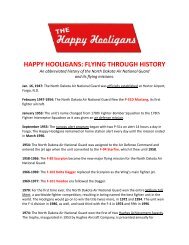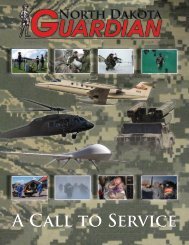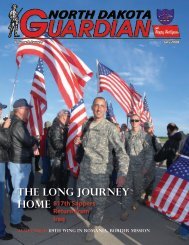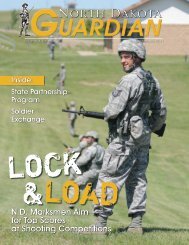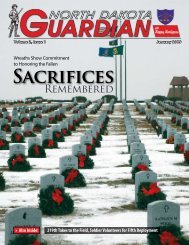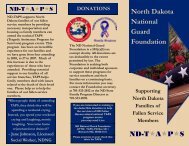Women's History Month - North Dakota National Guard - U.S. Army
Women's History Month - North Dakota National Guard - U.S. Army
Women's History Month - North Dakota National Guard - U.S. Army
Create successful ePaper yourself
Turn your PDF publications into a flip-book with our unique Google optimized e-Paper software.
<strong>North</strong> <strong>Dakota</strong><br />
GUARDIAN<br />
Volume 4, Issue 3 March 2011<br />
Celebrating<br />
Also Inside:<br />
School<br />
Support<br />
119th Wing<br />
in Japan<br />
Women’s <strong>History</strong><br />
<strong>Month</strong>
Inside This Issue<br />
Features<br />
Departments<br />
<strong>Guard</strong>ian Snapshots ............ pg. 12<br />
News Briefs .......................... pg. 14<br />
Sound Off!............................ pg. 15<br />
2 · <strong>Guard</strong>ian · March 2011<br />
4<br />
6<br />
8<br />
Class is<br />
in Session<br />
<strong>North</strong> <strong>Dakota</strong> military members can<br />
take advantage of a variety of incentives<br />
at <strong>North</strong> <strong>Dakota</strong> University System<br />
schools. Read how vet-friendly<br />
colleges accommodate Soldiers and<br />
Airmen whether they are called up for<br />
overseas missions or serve their states<br />
at home.<br />
Going<br />
Places<br />
Capt. Karin Halverson has traveled<br />
abroad more times than most and she’s<br />
always ready for more far-off journeys.<br />
The Happy Hooligan takes along her<br />
caring nature to help those in need.<br />
Halverson discusses why she’s drawn to<br />
volunteer her time and expertise miles<br />
from home.<br />
First<br />
in Line<br />
Chief Warrant Officer Four (Ret.) Bev<br />
Eng has had a lot of firsts in her nearly<br />
40-year military career. One of the first<br />
10 females to enlist in the N.D.<br />
<strong>National</strong> <strong>Guard</strong>, Eng later went on to<br />
become the first female training,<br />
advising and counseling officer at <strong>North</strong><br />
<strong>Dakota</strong>’s Officer Candidate School.<br />
The <strong>North</strong> <strong>Dakota</strong> <strong>Guard</strong>ian is an authorized publication for<br />
members, families and retirees of the N.D. <strong>National</strong> <strong>Guard</strong>.<br />
• Contents of the <strong>North</strong> <strong>Dakota</strong> <strong>Guard</strong>ian are not necessarily the<br />
official views of, or endorsed by, the U.S. Government, or the<br />
Department of the <strong>Army</strong> or Air Force.<br />
• Editorial content of this publication is the responsibility of<br />
the Joint Force Headquarters, N.D. <strong>National</strong> <strong>Guard</strong> ( JFND)<br />
Public Affairs Officer.<br />
• Printed by United Printing, a private firm in no way connected to<br />
the U.S. Government under exclusive written contract with the<br />
JFND. Reproduction is by the offset method with a circulation<br />
of 7,500.<br />
• The <strong>North</strong> <strong>Dakota</strong> <strong>Guard</strong>ian is published by the JFND Public<br />
Information Office, Box 5511, Bismarck, N.D. 58506-5511,<br />
701-333-2007<br />
ARTICLE SUBMISSIONS<br />
Contributions to the <strong>North</strong> <strong>Dakota</strong> <strong>Guard</strong>ian are<br />
encouraged! Send articles, photos and art to Editor, JFND<br />
PIO, Box 5511, Bismarck, N.D. 58506-5511.<br />
Electronic submissions are preferred. Please e-mail stories in<br />
Word format to: eric.william.jensen@us.army.mil<br />
Phone: 701-333-2195 Fax: 701-333-2017<br />
Digital photos should be at least 300 dpi.<br />
On the Cover<br />
Commander in Chief<br />
<strong>North</strong> <strong>Dakota</strong> Governor<br />
Jack Dalrymple<br />
The Adjutant General<br />
Maj. Gen. David A. Sprynczynatyk<br />
Chief of Public Affairs<br />
Capt. Dan Murphy<br />
Editor<br />
Sgt. Eric W. Jensen<br />
Contributors<br />
Senior Master Sgt. David H. Lipp<br />
Staff Sgt. Amy Wieser Willson<br />
Capt. Penny Ripperger<br />
Sgt. Brett. J. Miller<br />
Sgt. 1st Class David Dodds<br />
Sgt. Ann Knudson<br />
Master Sgt. Art Bakke<br />
Chaplain (Maj.) James Cheney<br />
Lt. Col. Robert Schulte<br />
Maj. Teresa Luthi McDonough<br />
Jackie Lorentz<br />
Spc. Cassandra Simonton<br />
Sgt. 1st Class Steve Urlacher<br />
Vital Roles: The nation has recognized March<br />
as <strong>Women's</strong> <strong>History</strong> <strong>Month</strong>. Women play an<br />
important role in the N.D. <strong>National</strong> <strong>Guard</strong> and in<br />
civilian professions. Tech. Sgt. Amy Strand, of the<br />
119th Medical Group, left, and 1st Lt. Nicolette<br />
Daschendorf, of Company B, 231st Brigade<br />
Support Battalion, serve in different branches<br />
of the N.D. <strong>National</strong> <strong>Guard</strong> and have different<br />
full-time career paths, yet each has their own<br />
family to care for as they juggle their roles as<br />
women in today's military. (Photo by Senior<br />
Master Sgt. David H. Lipp)<br />
Please visit us on the Web at:<br />
www.twitter.com/ndnationalguard<br />
www.youtube.com/ndnationalguard<br />
www.flickr.com/photos/ndguard<br />
www.facebook.com/ND<strong>National</strong><strong>Guard</strong>
View From the Top<br />
When I became a<br />
Happy Hooligan in<br />
1989, I started as an<br />
enlisted Airman in<br />
the Services Flight.<br />
Through excellent<br />
leadership, guidance<br />
and incredible<br />
role models, I was<br />
encouraged to take a<br />
commission, leading<br />
me on my own path<br />
of leadership. My predecessors<br />
have paved the way for individuals<br />
like me to enjoy a full military career<br />
without gender roadblocks.<br />
The 2011 theme of Women’s <strong>History</strong><br />
<strong>Month</strong> is “Our <strong>History</strong> is Our Strength,”<br />
and there are several fine examples of<br />
strong military women in our history, in-<br />
RMarch Celebrates <strong>Women's</strong> <strong>History</strong> <strong>Month</strong><br />
In March, I begin a new position at the cluding the stories of fellow <strong>Guard</strong>smen<br />
N.D. Air <strong>National</strong> <strong>Guard</strong> as the executive that appear in this issue of the <strong>North</strong><br />
officer for the 119 th Wing. As I prepare <strong>Dakota</strong> <strong>Guard</strong>ian.<br />
myself for this next step in my military The only female Medal of Honor<br />
career, I can’t help but think of all of the recipient, Dr. Mary Walker, was hon-<br />
opportunities that I have been given since<br />
Courtesy Photo<br />
I joined the military.<br />
I am fortunate to have joined the military<br />
in an era where<br />
there are few to no<br />
limitations on females.<br />
“My predecessors<br />
have paved the<br />
way for individuals<br />
like me to enjoy a<br />
full military career<br />
without gender<br />
roadblocks.”<br />
ored for her care and treatment of the<br />
sick and wounded during the Civil War,<br />
often at the risk of her own life. She was<br />
an accomplished<br />
doctor and patriot<br />
and successfully<br />
fought against sex<br />
discrimination in<br />
her time.<br />
There are other<br />
heroic stories about<br />
women who fought<br />
on the battlefield,<br />
survived prisoner<br />
of war camps and<br />
died in combat, all<br />
while disguised as<br />
men in order to<br />
serve their patriotic<br />
cause. These stories were revealed at the<br />
Women in Military Service for America<br />
Memorial dedication on Oct. 18, 1997,<br />
at Arlington <strong>National</strong> Cemetery.<br />
It’s hard for me to imagine a time<br />
before women were admitted into the<br />
service academies, allowed greater roles<br />
Maj. Teresa Luthi McDonough<br />
119th Wing Executive Officer<br />
<strong>North</strong> <strong>Dakota</strong> <strong>National</strong> <strong>Guard</strong><br />
in combat or could serve as pilots.<br />
Around the year I was born, the first<br />
females were appointed to the rank of<br />
general. The year I went to Basic Training,<br />
Eileen Collins entered the NASA<br />
program and later became the first<br />
woman commander of a space shuttle<br />
mission. These women, as well as the<br />
current and recently retired female leaders<br />
in our own state, are military pioneers<br />
who significantly contributed to the<br />
struggle for women’s rights.<br />
Because of our female military historical<br />
leaders, I have the privilege to<br />
serve without apprehension. I think our<br />
predecessors would have envisioned it<br />
that way, and would be proud of what<br />
we’ve become.<br />
“The leadership instinct you are born<br />
with is the backbone. You develop the funny<br />
bone and the wishbone that go with it.” —<br />
Elaine Agather, business woman<br />
Sincerely,<br />
Maj. Teresa Luthi McDonough<br />
Maj. Teresa Luthi McDonough (then a captain),<br />
stands next to a Humvee in the international<br />
zone, where she worked as the liason officer<br />
for the personnel security coordination center<br />
in Baghdad, Iraq, April 2006.<br />
www.ndguard.ngb.army.mil · 3
Soldiers, Airmen<br />
Sgt. Brett J. Miller<br />
<strong>North</strong> <strong>Dakota</strong> Universities Promote<br />
Military-Friendly Environments<br />
Ever since President Franklin Roosevelt signed the Servicemen’s<br />
Readjustment Act of 1944, American military<br />
servicemen and women have been enjoying the just perks<br />
of a college education courtesy of Uncle Sam.<br />
By the time the original bill ended 12 years later, nearly 8 million<br />
World War II veterans had participated in an education or<br />
vocational training program. Today, the promise of that original<br />
bill lives on in the form of the Montgomery G.I. Bill, and it’s as<br />
popular as ever among American Airmen, Soldiers, Sailors and<br />
Marines.<br />
These days, some states do a lot more than others when it<br />
comes to educational benefits for veterans. Few can compete with<br />
<strong>North</strong> <strong>Dakota</strong> and its colleges and universities.<br />
It is state law in <strong>North</strong> <strong>Dakota</strong> that all eligible active-duty<br />
servicemembers and veterans, their spouses and dependents<br />
— regardless of what state they are from — can attend <strong>North</strong><br />
<strong>Dakota</strong> University System schools at in-state rates. Members of<br />
the N.D. <strong>National</strong> <strong>Guard</strong> have additional benefits for which they<br />
can qualify.<br />
One need only look to <strong>North</strong> <strong>Dakota</strong>’s two largest universities<br />
— <strong>North</strong> <strong>Dakota</strong> State University in Fargo and the University of<br />
<strong>North</strong> <strong>Dakota</strong> in Grand Forks — for proof of vet-friendly environments.<br />
NDSU and UND aren’t the only military hot zones<br />
in <strong>North</strong> <strong>Dakota</strong>, but they educate 27,000, or 60 percent, of the<br />
45,000 college students enrolled in <strong>North</strong> <strong>Dakota</strong>’s 11-institution<br />
university system. They also have the majority of <strong>North</strong> <strong>Dakota</strong>’s<br />
veteran student population and are home to successful Reserve<br />
Officer Training Corps Battalions.<br />
At NDSU, there are about 450 students taking advantage of<br />
veteran benefits, including dependents. At UND, the number is<br />
about 540. Parsing out the UND figure even more shows there<br />
are about 150 <strong>National</strong> <strong>Guard</strong> Soldiers and Airmen enrolled at<br />
the school.<br />
The efforts in <strong>North</strong> <strong>Dakota</strong> to cater to veteran students is<br />
partly based on the fact they have unique needs compared to<br />
traditional students, but it’s also partly a way to thank these men<br />
and women for their service.<br />
“As a particular acknowledgement of an individual’s service to<br />
our country, we are committed to providing resources to veterans<br />
and military students which will assist in smooth navigation of<br />
the university environment and a successful educational experience,”<br />
said Kate Haugen, associate vice president for student<br />
affairs at NDSU.<br />
Alice Hoffert, UND associate vice president of enrollment<br />
management, said UND’s veteran-friendly ways are not the norm<br />
around the country, but it’s a posture that school officials adopted<br />
early as military deployments and call-ups became more commonplace.<br />
“They are an exceptional group of people, so we are interested<br />
in making exceptions for them,” Hoffert said. “We just felt they<br />
deserved special accommodations.”<br />
As Veterans Administration “Yellow Ribbon Schools,” both<br />
UND and NDSU pay additional costs beyond what the G.I. Bill<br />
does not cover for student veterans. Under an agreement, the<br />
schools and the VA split the remaining costs.<br />
Several other schools in <strong>North</strong> <strong>Dakota</strong> hold Yellow Ribbon<br />
agreements with the VA, including Jamestown College, Rasmussen<br />
College in Fargo and Bismarck and the University of Mary.<br />
Hoffert said UND routinely works with veteran students when<br />
it comes to tuition and fee deadlines, making sure to waive late<br />
fees when their enrollment is affected by military duty. The same<br />
goes for housing contracts, which are pro-rated based on their<br />
military duty schedule so they are not stuck paying for a university<br />
residence they can’t use.<br />
Also, if a veteran gets called away from class for any kind<br />
of military duty longer than 14 days, their tuition and fees are<br />
refunded at 100 percent.<br />
<strong>North</strong> <strong>Dakota</strong> veteran students are eligible to take advantage<br />
of the state’s “drop” policy that allows them to halt classes without<br />
penalty if they are called away for military duty.<br />
Kaarin Remmich, VA certifying official at NDSU, said that<br />
their school already is urging those who might be needed for<br />
flood duty around the state this spring to think about the academic<br />
ramifications of a potential call-up.<br />
“Right now, we are working on expanding email communication<br />
to students to provide dates and deadline information …<br />
so that students can make early decisions on whether to remain<br />
registered,” she said.<br />
At UND, instructors are given the discretion to work with<br />
veteran students to register a grade as “incomplete,” or, if enough<br />
progress has been made during a semester, they can issue a grade<br />
based on the students’ performance to that point.<br />
“When I was called up to assist in flood-fighting efforts in the<br />
middle of a semester, my instructors were very flexible and ac-<br />
• By Sgt. 1st Class David Dodds, 141s
Jackie Lorentz<br />
Far left, <strong>North</strong> <strong>Dakota</strong> State University (NDSU)<br />
Rerserve Officers’ Training Corps cadets, from<br />
left to right, Amity Blohm, Corey Arnold, (who is<br />
also a member of the N.D. <strong>Army</strong> <strong>National</strong> <strong>Guard</strong>'s<br />
Company C, 188th Air Defense Artillery) and Anthony<br />
Hokanson visit on campus at NDSU Dec. 9.<br />
Left, Air Force Andrew Anderson, of the University<br />
of <strong>North</strong> <strong>Dakota</strong> ROTC battalion and also a<br />
senior airman in the 119th Wing of the N.D. Air<br />
<strong>National</strong> <strong>Guard</strong>, stands in front of Twamley Hall<br />
at UND Feb. 22.<br />
commodating,” said Jesse Wolff, a UND<br />
communication major from Beulah,<br />
N.D. Wolff served in the N.D. <strong>National</strong> <strong>Guard</strong> from 2004 to 2010 and was deployed for<br />
Operation Iraqi Freedom from 2005 to 2006.<br />
Veteran students at UND also are eligible for priority registration no matter if they<br />
are an incoming freshman or a transfer student from another school. This ensures that<br />
veterans get the classes they need sooner. Typically, UND students register based on the<br />
amount of credit hours they have accrued.<br />
Another important component of UND’s handling of veterans’ needs is the “one-stopshop”<br />
setup of its Veterans Affairs office. Carol Anson, UND’s certifying official, has the<br />
power to work with students and take care of matters that, at many other schools, would<br />
be handled by multiple offices. All she needs to see is a verification of military orders.<br />
This model is especially valuable in cases where veteran students are called away to duty.<br />
“We don’t want the student using up their valuable time going from one office to the<br />
next,” Hoffert said. “We want them to be able to spend that time with their Families.”<br />
Likewise, NDSU is dedicated to making its veteran students’ experience as seamless<br />
and pleasant as possible. Recently, the school elevated the status of its VA certifying official<br />
to full-time and dedicated a new suite of offices for veteran affairs. The office holds<br />
a self-service computer kiosk for veteran students to fill out forms, with the advantage of<br />
being centrally located for assistance from NDSU VA personnel.<br />
NDSU created three work-study positions to assist with walk-in traffic, incoming<br />
phone calls and to answer questions related to benefits.<br />
NDSU also has a dedicated phone line for veteran students who want to speak directly<br />
to the NDSU VA staff, including the certifying official. Another communication<br />
upgrade is a new e-mail address for veteran students who have specific questions on VA<br />
matters.<br />
“This has helped to send e-mail directly to the VA area without having to be routed<br />
in and through the general Registration and Records e-mail account, allowing for faster<br />
response time,” Remmich said.<br />
Hoffert said that another major UND initiative has been to offer preferential enrollment,<br />
into certain classes, for servicemembers and veterans. Initially, sections of psychology<br />
and English composition were set up.<br />
Instructors for the courses were handpicked so that they had some level of prior<br />
military involvement or experience with servicemen and women. The courses were<br />
determined to be ones that most met the needs of returning veterans. The results were so<br />
successful that UND has decided to add sociology and speech to the list of veterans-only<br />
class sections.<br />
“The classes were chosen so that students of similar life experiences could be together<br />
and write about their shared experiences, think about these experiences, speak about<br />
these experiences and learn about the social aspects of these experiences,” Hoffert said.<br />
Hoffert said the idea for veteran-specific classes stemmed from the school’s Military<br />
t Maneuver Enhancement Brigade •<br />
Affairs Committee, which comprises community<br />
and university members who are in<br />
the military or work closely with military<br />
organizations.<br />
“We get a really good sense from this<br />
group about what veterans and the military<br />
would like to see from UND,” Hoffert said.<br />
At NDSU, a Veterans Reintegration<br />
Committee was formed several years ago<br />
to assess the needs and issues of returning<br />
veterans. This committee has since evolved<br />
into an advisory committee for the campus<br />
that includes The Office of Admission,<br />
Counseling Center, Disability Services,<br />
TRiO programs and Veterans Upward<br />
Bound, the VA certifying official, student<br />
representation, two faculty members and<br />
representatives of the ROTC.<br />
Remmich said the committee meets<br />
regularly and, in addition to its veteran<br />
advocacy role, it organizes campus-wide<br />
events, such as a flag-raising ceremony on<br />
Veterans Day.<br />
Philip Parnell, director of online enrollment<br />
at UND, said his school’s efforts to<br />
serve veteran students has earned it national<br />
recognition from organizations such as<br />
G.I. Jobs, and most recently, from Military<br />
Advanced Education, which named UND<br />
a “Top Military-Friendly College for 2010-<br />
2011.” G.I. Jobs also named Bismarck State<br />
College as being in the top “15 percent of<br />
military-friendly schools.”<br />
Though not the central goal of UND’s<br />
military-friendly efforts, Parnell referenced<br />
a 65 percent increase in the number of<br />
veteran students from 2008 to now.<br />
The increase also could be attributed to<br />
a ramped up nationwide effort to recruit<br />
veteran and military students to take<br />
classes from UND.<br />
“Serving our veterans the way we do at<br />
UND is a way of giving back for all they’ve<br />
done for us,” Parnell said. “We have been<br />
honoring our veterans one way or another<br />
for years on the UND campus. It’s the right<br />
thing to do — it’s in our culture.”<br />
For more information about military<br />
educational benefits, contact the Veterans<br />
Affairs office at your school.
Ambassador<br />
for Hope<br />
Capt. Karin Halverson is surrounded by<br />
children living in a Port-au-Prince, Haiti,<br />
tent city after the catastrophic Jan. 12,<br />
2010, earthquake. Halverson was a<br />
civilian medical volunteer serving with<br />
Project Hope during the three weeks<br />
immediately following the earthquake.<br />
Courtesy Photo<br />
Halverson Renders Care<br />
While Traveling Abroad<br />
She’s been to Iraq, Curacao, Puerto Rico, Ecuador, Columbia, Nicaragua, Ghana, Haiti twice<br />
and Panama three times, but when asked if there was anything she would do differently, Capt.<br />
Karin Halverson’s response was, “Nothing, except I wish I would have deployed more.”<br />
Such a response does not surprise people who know Halverson. A 20-year veteran of the<br />
N.D. Air <strong>National</strong> <strong>Guard</strong>, she has experienced more in her travels than most could ever imagine.<br />
Whether it is through the military or in her civilian career as a certified nurse practitioner, Halverson<br />
finds a way to use her skills to help others while fulfilling her passion to see the world.<br />
She began her military career in the life support career field, a position that appealed to Halverson’s<br />
adventurous spirit.<br />
“The training was great! They bring you out into the mountains and you live off the land for a<br />
week. We learned skills in escape and evasion as well as survival and recovery,” Halverson said. “We<br />
camped, ate bugs and dug holes to filter water.”<br />
It was while she served in life support that she went on missions to Panama for Coronet Nighthawk,<br />
an Air <strong>National</strong> <strong>Guard</strong> counter-narcotic air patrol operation. When the mission moved to<br />
Curacao, and later Puerto Rico, she raised her hand to deploy to those locations, too.<br />
By Capt. Penny Ripperger, 119th Wing<br />
After serving for 12 years in<br />
life support, Halverson took<br />
a commission and joined the<br />
119 th Wing Medical Squadron.<br />
“At first I really didn’t want<br />
to do the same thing at the Air<br />
<strong>Guard</strong> that I was doing on the<br />
civilian side. Then, with the<br />
conversion, life support stopped<br />
deploying and the Medical<br />
Squadron was,” Halverson said.<br />
The first time Halverson<br />
deployed as a nurse, she traveled<br />
alone to Uganda and met up<br />
with 10 <strong>Guard</strong> medics from<br />
across the United States.<br />
“Electricity would be turned<br />
off at 11p.m. every night. We<br />
would sit by candlelight. The<br />
Marines and Soldiers would<br />
talk about Iraq and the Uganda<br />
Soldiers would talk about the<br />
Congo and Sudan. It was a surreal<br />
experience,” Halverson said.<br />
While in Uganda, their team<br />
saw about 1,000 patients a day.<br />
Prior to that deployment,<br />
Halvorson learned that the<br />
119 th Wing Medical Squadron<br />
would be deploying to Ghana<br />
just two weeks after she returned<br />
from Uganda.<br />
“I was trying to decide if I<br />
should go and then someone<br />
asked me, ‘Why wouldn’t you<br />
go; it’s Africa!’ So I went to<br />
Africa twice in four weeks,”<br />
Halverson said.<br />
Her two teenaged children<br />
have understood, and the<br />
oldest— a freshman in college<br />
— clearly has his mom’s<br />
wanderlust bug, having taken a<br />
trip to Europe so far. Both kids<br />
want to follow in their mother’s<br />
footsteps and experience the<br />
world.<br />
Her next big adventure<br />
was traveling to Iraq, where
she worked in a tent hospital for 45 days. Even though she<br />
had experience working in an intensive care unit in a civilian<br />
hospital, nothing could prepare her for what she encountered<br />
on this deployment.<br />
“I had never witnessed trauma like that. We would have<br />
eight or nine casualties coming in at once with massive damage,<br />
but, in the face of chaos, sadness and carnage, we had a<br />
really good team. Morale was high,” she said.<br />
Halverson described how the need at the hospital was great.<br />
“Many people from other sections would volunteer at the<br />
hospital. After working 12 hours on the flight line, they’d<br />
come and work at the hospital a couple more hours,” she said.<br />
“I was there for just a moment. I would love to go back.”<br />
Iraq definitely did not subdue the travel bug for Halverson.<br />
In 2010, she volunteered to go to Haiti for three weeks as a<br />
civilian with Project Hope. Halverson boarded a Navy ship<br />
and ran immunization clinics in Ecuador, Columbia and Portau-Prince,<br />
Haiti, on that mission.<br />
She returned to Port-au-Prince a second time following the<br />
devastating earthquakes in 2010.<br />
“I went to the general hospital there and all the patients were camped out in tents in<br />
the parking lots because people were scared to sleep inside the hospital. It was completely<br />
unreal,” Halvorsen said, who experienced a 4.7 magnitude earthquake her first night<br />
there.<br />
What makes a person want to work in such extreme environments? Halverson attributes<br />
much of her desire to work transculturally to her time that she worked as a<br />
Hospice nurse from 1999 to 2007.<br />
“There is a huge similarity in end-of-life care and transcultural care. You have to make<br />
sure it’s not about your own motives or twisting something to fit your own belief. Rather,<br />
you want to meet them where they are at in their own beliefs.” Halverson said. “We tend<br />
to be egocentric in our country, but if you stop and ask yourself, what does this illness<br />
mean to them, in their own context, their own culture, it could be very different from<br />
what we believe.”<br />
Halverson, of the 119th Medical Group, demonstrates the technique for<br />
applying a tourniquet to the upper arm area of Senior Airman Bradley<br />
Kohlhase, of the 119th Communications Flight, Feb. 6.<br />
Courtesy Photo<br />
Capt. Karin Halverson<br />
takes time to pose for a<br />
photo during her 2007<br />
deployment at the<br />
332nd Air Force<br />
Theater Hospital, Joint<br />
Base Balad, Iraq.<br />
Ironically, Halverson explained that<br />
Hospice taught her a lot about living, as<br />
well as grace and mortality.<br />
“Working with people at the end<br />
of their lives is amazing. To be able to<br />
advocate for the patient, when someone<br />
is given the options of how they want<br />
to live — not how to die — it is really<br />
beautiful and empowering to do it the way<br />
they want it done. It’s better than doing<br />
CPR on someone who’s never really been<br />
given the opportunity or option to decide,”<br />
Halverson said.<br />
Through her travels, particularly<br />
in Iraq and Afghanistan, Halverson<br />
hopes that end-of-life care is<br />
improving in military hospitals in<br />
warzones.<br />
“When you watch people<br />
die, you see a kind of awareness<br />
between awake and asleep. I’ve<br />
seen it over and over again; people<br />
certain that they have spoken to<br />
those that went before them or<br />
people just aware of things that<br />
they were never aware of before.<br />
When someone is simply not<br />
going to survive, if you shift your<br />
focus, it can really make a difference<br />
in their last moments,”<br />
Halverson said.<br />
Halverson describes her time<br />
with her patients at Hospice a true<br />
privilege, just as it was in her other<br />
travels, such as to Iraq.<br />
“Here are people who were willing<br />
to risk everything. It was my<br />
privilege to receive them, wounded,<br />
and be able to try to help them,”<br />
Halverson said.<br />
Senior Master Sgt. David H. Lipp<br />
www.ndguard.ngb.army.mil · 7
Leading from the Front<br />
Eng Looks Back on Multi-Role Career<br />
Courtesy Photo<br />
Chief Warrant Officer Four (Ret.) Beverly Eng<br />
wouldn’t be described as an imposing figure by those<br />
who know her. However, Brig. Gen. William Seekins,<br />
N.D. <strong>National</strong> <strong>Guard</strong> land component commander,<br />
remembers a time when the Mott-native and mother of three<br />
could intimidate any young Soldier going through <strong>North</strong> <strong>Dakota</strong>’s<br />
Officer Candidate School (OCS) in the late 70s.<br />
Eng was the first female training, advising and counseling<br />
(TAC) officer to guide future leaders toward commissioning in<br />
the N.D. <strong>National</strong> <strong>Guard</strong>.<br />
Seekins recalls doing a lot of push-ups his first day at OCS; a<br />
good portion of them doled out by Eng. Specifically, he remembers<br />
spotting her “Smokey the Bear hat” and fumbling to render<br />
the proper greeting of the day.<br />
“Before I could even snap a salute off, all I could hear were the<br />
dreaded words, ‘Seekins, drop and give me 20,’” he said.<br />
After fulfilling the order, Seekins assumed that his debt had<br />
been paid and requested permission to recover. Eng wasn’t finished.<br />
“I never really understood or even heard everything she was<br />
telling me in her very strong voice, except something about<br />
Sgt. Ann Knudson<br />
Above, nine of the first 10 women to enlist in the N.D. <strong>Army</strong> <strong>National</strong> <strong>Guard</strong> are shown in this<br />
photo from 1974 including Chief Warrant Officer Four (Ret.) Bev Eng (sitting on right side of cannon).<br />
Eng said that female Soldiers were presented with "unique challenges" then. She said that<br />
during that time there was no housing on Camp Grafton to accomodate both men and women.<br />
Female Soldiers were housed at Lake Region State College in Devils Lake, N.D. Below, Brig. Gen.<br />
William Seekins, N.D. <strong>National</strong> <strong>Guard</strong> land component commander, visits with Eng<br />
during her retirement ceremony at Raymond J. Bohn Armory, Bismarck, Jan. 9.<br />
Story by Sgt. Eric W. Jensen
my boots and my inattention to detail,”<br />
Seekins said. “Of course, I immediately<br />
looked down at my boots, breaking my<br />
position of attention, which again brought<br />
the dreaded, ‘Seekins, drop and give me<br />
twenty!’”<br />
Eng’s version differs slightly.<br />
“Now, I wasn’t mean, but he remembers<br />
me,” she said. “But I didn’t get loud with<br />
my speech. My pitch got higher. Yeah, he<br />
remembers me asking him to ‘give me 20.’”<br />
In 1978, seeing a female Soldier, let<br />
alone a commissioned officer, within the<br />
N.D. <strong>Army</strong> <strong>National</strong> <strong>Guard</strong>’s ranks was<br />
rare, and maybe even startling. When she<br />
joined the organization in 1974, Eng was<br />
one of only 10 women who enlisted that<br />
year.<br />
“The guys did a lot of double takes,” she<br />
said. “They cleaned up their language quite<br />
a bit. They would stumble and fall, and<br />
they didn’t know how to address you.”<br />
Eng never intended to set benchmarks<br />
or be the first at anything. But that’s what<br />
happened.<br />
“I had a lot of firsts, but that wasn’t<br />
really why I was there,” she said. “I was doing<br />
what I wanted to do. It wasn’t because<br />
I wanted to be the first female officer, I<br />
just wanted to make a difference.”<br />
Over her notable military career, Eng<br />
did make a difference and made an impression<br />
on her peers in a variety of roles.<br />
She is one of few <strong>North</strong> <strong>Dakota</strong> <strong>Guard</strong>smen<br />
to have held three different military<br />
statuses, from enlisted to commissioned<br />
officer, and later, a warrant officer.<br />
On Jan. 9, Eng was honored by friends,<br />
family and fellow <strong>Guard</strong>smen with a<br />
retirement ceremony at Raymond J. Bohn<br />
Armory, the culmination of a nearly 40-<br />
year career in the military.<br />
First Impressions<br />
Eng’s immersion into military service<br />
began in the Vietnam-era, when she<br />
joined the active-duty <strong>Army</strong> in 1969 as a<br />
medical corpsman. Enticed by education<br />
incentives — the Montgomery G.I. Bill,<br />
in particular — Eng entered basic training<br />
at Fort McClellan, Ala. <strong>Army</strong> regulations<br />
at the time stated that women younger<br />
than 21 could not enlist without parental<br />
consent. Her father, who had spent three<br />
years in the <strong>Army</strong>, and mother obliged<br />
and supported their daughter’s decision to<br />
serve.<br />
“I joined right out of high school. I<br />
wanted to do something with my life,”<br />
, Joint Force Headquarters<br />
Above, Eng, second from right, is pictured with fellow TAC<br />
officers instructing at <strong>North</strong> <strong>Dakota</strong>'s Officer Candidate<br />
School in July 1979. Right, Eng was featured in the April 1978<br />
edition of the NoDak <strong>Guard</strong>sman for being the first woman<br />
in the N.D. <strong>Army</strong> <strong>National</strong> <strong>Guard</strong> to “enter and complete the<br />
Engineer Officer Basic Course.”<br />
Eng said. “I didn’t know what I wanted to<br />
do (specifically) anyway.”<br />
She had no indecision when choosing<br />
a military profession, which was straightforwardly<br />
facilitated by the <strong>Army</strong>. Female<br />
Soldiers had the choice of two military<br />
occupations, medical or clerical. Their<br />
male counterparts were separated into<br />
their own basic training platoons. Much<br />
of the curriculum and routine duties that<br />
comprise basic training remained the<br />
same, though. Eng remembers maintaining<br />
an orderly, neat locker and continually<br />
buffing and waxing “God’s aisle,” a term<br />
used to reference the center walkway of<br />
the Soldiers’ open bay barracks.<br />
The physical training (PT) regimen was<br />
a different story altogether.<br />
Eng describes the PT uniform at the<br />
time as “ugly.” Female Soldiers’ exercise<br />
wear was “very basic” and “starched to the<br />
hilt” with a short-sleeved, blue shirt and<br />
a pair of shorts accompanied by a wraparound<br />
skirt with buttons running down<br />
the front.<br />
“And our PT consisted of just running<br />
around in the gym three or four times,”<br />
she said. “There were no 3-mile, 4-mile<br />
runs.”<br />
Center of Attention<br />
After basic training, Eng packed up for<br />
her advanced individual training (AIT) in<br />
Fort Sam Houston, San Antonio, Texas,<br />
where she received an intimate look into<br />
the <strong>Army</strong> medical field she had chosen.<br />
Her class was given a tour of Brooke <strong>Army</strong><br />
Medical Center, a burn center that treated<br />
Soldiers returning from the Vietnam War.<br />
“That was an experience,” she said.<br />
“Those poor guys coming back from Vietnam;<br />
I mean they just groaned and it was<br />
unbelievable.”<br />
Eng, however, was comfortable with the<br />
path she was on. Her first active-duty post<br />
was at Ireland <strong>Army</strong> Hospital in Fort Knox,<br />
Ky., where she worked with Republic of<br />
Vietnam returnees, and later in the obstetrician/gynecology<br />
clinic as a nurse’s aide.<br />
As comfortable as she was, though, Eng<br />
still remembers the difficulties that accompanied<br />
wearing the uniform during her<br />
time on active duty, especially as a female<br />
Soldier.<br />
Courtesy Photo
“Vietnam was going on at the time and<br />
it was just a real negative atmosphere,” she<br />
said. “You couldn’t even go into a grocery<br />
store with your uniform on without all the<br />
cat calls and all the car horns honking. It<br />
was really hard to deal with.”<br />
The trade-off was significant for Eng.<br />
Upon completion of her active service, she<br />
took a two-year break. In 1974, she enlisted<br />
in the N.D. <strong>National</strong> <strong>Guard</strong>, an organization<br />
she would be a part of for the next<br />
36 years. In addition, she attended college<br />
and graduated with a bachelor’s degree in<br />
social work and a minor in psychology from<br />
the University of Mary in 1976 using the<br />
G.I. Bill she had obtained from her active<br />
service.<br />
Among Equals<br />
Eng remembers a <strong>Guard</strong> dining event<br />
in which her male colleagues among the<br />
TAC officer cadre prodded her incessantly<br />
to “cut loose.” Former colleague Col. (Ret.)<br />
John Hocking, in particular, was intent on<br />
getting the young officer to “say something<br />
bad.”<br />
“You know, the <strong>Guard</strong> then was different<br />
than it is now. They wanted me to swear<br />
and stuff,” she said.<br />
Customarily, the treatment Eng received<br />
from her peers was “very lady-like.” But<br />
the request for profanities became tiresome<br />
and she let them know during the dinner<br />
by asking Hocking, “OK, would you please<br />
pass the (expletive) peas?”<br />
“After that, they let me alone,” Eng said.<br />
“I was equal.”<br />
But she had proven that she could hang<br />
with the best of the N.D. <strong>National</strong> <strong>Guard</strong><br />
many times and would do so again and<br />
again.<br />
In 1977, Eng attended the Woman Officer<br />
Orientation Course, an 11-week direct<br />
commissioning program that required a<br />
four-year college degree to attend. Upon<br />
completion, she was commissioned as a<br />
second lieutenant. From there, she became<br />
the first female in the N.D. <strong>National</strong> <strong>Guard</strong><br />
to enter and complete the Engineer Officer<br />
Basic Course in 1978. That same year, she<br />
became the first female TAC officer to<br />
work at the N.D. <strong>National</strong> <strong>Guard</strong>’s Officer<br />
Candidate School.<br />
Eng served as a commissioned officer for<br />
14 years, acquiring the rank of captain.<br />
“I wanted to be the best that I could be,”<br />
she said. “I just thought I had something to<br />
offer.”<br />
In 1988, Eng still had much more to<br />
Sgt. Ann Knudson<br />
Eng, is joined by her family, from left to right, fiancé Richard Breuer; granddaughter, Keeley McCory and daughters, Shayna and<br />
Kristi, during her retirement ceremony at Raymond J. Bohn Armory, Bismarck, Jan. 9.<br />
offer the N.D. <strong>National</strong> <strong>Guard</strong>. She took an appointment as a chief warrant officer, working<br />
in a variety of capacities, including personnel technician, budget assistant, selective<br />
service officer, communications management specialist and program analyst.<br />
She said that working as the commander of the Selective Service System, <strong>North</strong> <strong>Dakota</strong><br />
Detachment, has been one of the highlights of her lengthy military career. The position<br />
came with multiple responsibilities. Eng was tasked with providing continuation training<br />
for county representatives and ensuring 100 percent high school registration of 17- and<br />
18-year-old men into the Selective Service.<br />
“It’s kind of like managing your own business,” she said.<br />
For all of the experience she received during her military career, Eng is appreciative.<br />
“I initially enlisted because I was such a wallflower. I just had to break out of that mode,”<br />
she said. “So, the N.D. <strong>Army</strong> <strong>Guard</strong> was really good to me in that respect. It gave me a lot<br />
of challenges.”<br />
Eng hopes that young women enlisting in the military will embrace those challenges and<br />
recommends they pursue the opportunities available to them.<br />
“Specialties have opened up greatly. I mean the sky’s the limit,” she said. “Tell people<br />
what you think and what you feel. Go after what you want.”<br />
Eng (second row, first on the left), is pictured with her Woman Officer Orientation Course class April 1976.<br />
Courtesy Photo<br />
10 · <strong>Guard</strong>ian · February 2011
Courtesy Photo<br />
Practice<br />
Makes<br />
Perfect<br />
By Capt. Penny Ripperger<br />
119th Wing<br />
Master Sgt. Art Bakke<br />
Tech. Sgt. Allan Garnett, of<br />
the 119th Logistics Readiness<br />
Squadron, Air Terminal<br />
Operations element, drives a<br />
K-loader in preparation for a C-5<br />
Galaxy cargo unload/upload at<br />
Yokota Air Base, Japan.<br />
119th ATO Travels for Training<br />
On New Mission Skill Sets<br />
FForty-one <strong>North</strong> <strong>Dakota</strong> Airmen boarded a KC-135 aircraft<br />
bound for the Far East for a two-week annual training deployment<br />
to Japan Jan.22. The mission was a monumental occasion. It was<br />
the first time that N.D. Air <strong>Guard</strong> members of the newly formed<br />
119 th Wing Air Terminal Operations (ATO) element would get<br />
hands-on experience with equipment that will be used with the<br />
upcoming C-27J Spartan mission.<br />
“We were assigned to the 730th Air Mobility Squadron located at<br />
Yokota Air Base, Japan. The purpose of this deployment was to keep<br />
our Airmen proficient in their positions by using skills they’ve been<br />
training for in a real-world environment,” Chief Master Sgt. John<br />
Nordquist, 119 th Wing ATO manager, said. “Much of the equipment<br />
that we were working on is equipment that we will eventually have<br />
here at the 119 th Wing or equipment that we need to train on in the<br />
new mission. The training received in Japan was invaluable.”<br />
Master Sgt. David Larson, 119 th Wing ATO superintendent,<br />
described the trip as one of the best in regard to the training. This<br />
was his third trip to Japan. He said 119 th Wing Airmen got the opportunity<br />
to work in multiple areas in the ATO career field.<br />
“Some of our personnel were assigned to ramp service, a couple<br />
to Air Terminal Operations Control, one to load planning and a<br />
couple others were in between cargo processing and special handling,”<br />
Larson said. “Eventually, we found the Logistical Readiness<br />
Squadron at Yokota, where they had an air rigging operation,<br />
which will be the cornerstone of our future mission at the 119th<br />
ATO Element.”<br />
ATO wasn’t the only squadron to experience this unique deployment.<br />
Twenty-four Airmen from the Force Support Squadron,<br />
three Airmen from the 119 th Wing Medical Squadron and<br />
two first sergeants took part, as well.<br />
The large size of the Force Support Squadron at Yokota Air<br />
Base offered many opportunities for the 119 th Wing Airmen to<br />
train in their respective specialties. Some of these areas included<br />
the aerospace dining facility, fitness center, readiness, personnel<br />
and recruiting.<br />
“Our mission was to spread the word about the Air <strong>National</strong><br />
<strong>Guard</strong> and (its various) programs,” Tech. Sgt. Tina Sly, 119th<br />
Wing production recruiter said. She was one of three recruiters<br />
who went to Japan from the 119 th Wing.<br />
“There was a lot of interest, not too many who were willing to<br />
come to <strong>North</strong> <strong>Dakota</strong>, though,” she joked.<br />
The deployment was one that will be remembered by all who<br />
went, not only for the training, but also because of the incredible<br />
hosts that made the visit even more enjoyable.<br />
“The active duty, both military and DOD-civilians, were excellent<br />
hosts, very professional and accommodating. We couldn’t<br />
have been treated better,” Larson said.<br />
“It’s about taking care of your people in a deployed atmosphere,<br />
and this trip reminded us that the military is a huge family, an<br />
extended family all over the world,” Nordquist said.<br />
Tech. Sgt. Amber Rolph, Senior Airman Erin Weaver and Staff Sgt. Michelle Mahrer, all of<br />
the 119th Force Support Squadron, work alongside civilian Ruby Cawilan, of the 374th<br />
Force Support Squadron, as they check in guests at the main desk of the Kanto Lodge at<br />
Yokota Air Base.<br />
Master Sgt. Art Bakke<br />
From left to right, Master Sgt. Art Bakke, Master Sgt. Gary Koslofsky, Tech. Sgt. Leslie Ressler, Tech.<br />
Sgt. Allan Garnett, Staff Sgt. Terry Davis (holding Happy Hooligan flag), Staff Sgt. Earnest Trosen and<br />
Staff Sgt. Teresa Pavljuk display the Hooligan colors after recovering and field-packing a G-12 cargo<br />
parachute at the Mount Fuji drop zone in Japan.<br />
www.ndguard.ngb.army.mil · 11
Madelyn Walters, left, of Fargo, gets<br />
accustomed to the fit of her night vision<br />
goggles as her mother, Sgt. Erin Walters,<br />
of the 141st Maneuver Enhancement<br />
Brigade, adjusts the head harness for<br />
Eliza Dodds, of Grand Forks. The girls<br />
were preparing for a scavenger hunt in<br />
a pitch dark room of the Fargo Armed<br />
Forces Reserve Center. They were among<br />
two dozen family members who took<br />
part in 141st MEB Family Day events Jan.<br />
22 in Fargo. As part of the day, children of<br />
MEB Soldiers wore camouflage face paint<br />
and learned about <strong>Army</strong> weapons and<br />
safety and were able to shoot paintball<br />
rifles at targets in the armory's indoor<br />
firing range. Madelyn's father, Sgt. Dan<br />
Walters, is a member of the 188th Engineer<br />
Company. Eliza's parents are Sgt. 1st<br />
Class David Dodds, of the 141st MEB, and<br />
Jennifer Dodds, of Grand Forks.<br />
Sgt. 1st Class David Dodds<br />
Sgt. 1st Class Steve Urlacher<br />
1st Sgt. Richard Marschner, of<br />
Joint Force Headquarters,<br />
enjoys a chilly day ice fishing<br />
with his daughter, Rachel, at<br />
the N.D. Game and Fish<br />
Department pond in Bismarck<br />
Feb. 19. The N.D. <strong>National</strong><br />
<strong>Guard</strong>'s Child and Youth<br />
Program, N.D. Game and<br />
Fish Department and Lincoln<br />
Sportsman’s Club sponsored the<br />
event to give military parents<br />
a chance to spend quality time<br />
with their children by teaching<br />
them the basics of ice fishing.<br />
Spc. Brandon Pulst, left, of the 3662nd<br />
Maintenance Company, pursues a<br />
fellow competitor at the World<br />
University Games in Erzurum, Turkey, Jan.<br />
29. Pulst was one of only four <strong>National</strong><br />
<strong>Guard</strong>smen across the country chosen to<br />
participate in the biathlon portion of the<br />
World University Games sporting event.<br />
Read more on page 14 in this issue of the<br />
<strong>North</strong> <strong>Dakota</strong> <strong>Guard</strong>ian.<br />
GUARDIAN<br />
Snapshots
Senior Master Sgt. David H. Lipp<br />
Senior Airman Theta Olson, of the<br />
119th Civil Engineer Squadron,<br />
gives instructions on post attack<br />
reconnaissance team procedures<br />
following a simulated chemical<br />
agent attack at the N.D. Air<br />
<strong>National</strong> <strong>Guard</strong> during a unit<br />
training assembly Feb. 6.<br />
Above, Staff Sgt. Trevor Derosier plays catch with his son, Bristen, at the<br />
Alerus Center in Grand Forks before the 1st Battalion, 188th Air Defense<br />
Artillery Regiment’s Freedom Salute Feb. 13. The event recognized about 75<br />
N.D. <strong>Army</strong> <strong>National</strong> <strong>Guard</strong> Soldiers who returned from Afghanistan and Iraq<br />
in December after a yearlong mobilization.<br />
Spc. Cassandra Simonton<br />
Staff Sgt. Kellynn Johnston, right, and Senior Master Sgt. Robert Schultz,<br />
both of the 119th Security Forces Squadron, simulate CPR on a mannequin<br />
during a training exercise Feb. 18 at the N.D. Air <strong>National</strong> <strong>Guard</strong>.<br />
Senior Master Sgt. David H. Lipp
NewsBriefs<br />
N.D. <strong>Guard</strong> Exercises<br />
Flood Response Plan<br />
The N.D. <strong>National</strong> <strong>Guard</strong> further<br />
refined its flood-fighting operations in<br />
support of civil authorities during a flood<br />
response exercise at Fraine Barracks,<br />
Bismarck, Feb. 12-13. The exercise was<br />
the culmination of the <strong>Guard</strong>’s planning<br />
process that began last November.<br />
The exercise scenario simulated a week<br />
of warm temperatures leading to a rapid<br />
melt, which was complicated by steady<br />
rainfall. Rising floodwaters created the<br />
need for flood barriers, generators, dike<br />
security patrols, traffic control, sandbagging,<br />
quick reaction forces and evacuation<br />
assistance.<br />
“The purpose of the exercise is to fine<br />
tune everyone’s thinking on what they<br />
need to do in the event we are ordered<br />
to respond to flooding,” said Col. Mike<br />
Wobbema, the director of Joint Staff,<br />
N.D. <strong>National</strong> <strong>Guard</strong>. “One of the lessons<br />
we have learned is that we are not in this<br />
alone. During the 2009 flood fight, we<br />
were assisted by <strong>Guard</strong>smen from several<br />
states.”<br />
Although not directly participating in<br />
the flood response exercise, representatives<br />
from South <strong>Dakota</strong>, Minnesota, Missouri,<br />
Nebraska and Iowa were present to<br />
discuss their potential flood situations and<br />
how each state might assist each other, if<br />
necessary.<br />
The <strong>National</strong> <strong>Guard</strong> is the first military<br />
responder to emergencies or disasters and<br />
always as a supporting agency rather than<br />
a lead agency. The biggest difference between<br />
this year’s potential <strong>Guard</strong> response<br />
as compared to previous years’ response<br />
is the number of Soldiers and Airmen<br />
available if needed. Currently, only a dozen<br />
<strong>Guard</strong>smen are mobilized, far fewer than<br />
during the response efforts during 2009<br />
and 2010 spring flooding.<br />
Scholarships Available to<br />
Military Members, Families<br />
The city of Fargo recently honored its<br />
military members by donating to a new<br />
scholarship fund created for military families.<br />
The city donated $1,000 to the <strong>North</strong><br />
<strong>Dakota</strong> Dollars for Scholars (NDDFS)<br />
Military Scholarship Fund, with funds being<br />
reserved for full-time students who are<br />
dependents of N.D. military members.<br />
“In recent years, <strong>North</strong> <strong>Dakota</strong> military<br />
members have been activated at one of the<br />
highest rates per capita in the nation,” said<br />
retired Col. Tom Kenville, of West Fargo.<br />
“These members and their families have<br />
made significant sacrifices for the good of<br />
our state and country, and this fund has<br />
been developed to honor our dedicated<br />
servicemen and women and their families.”<br />
For 2011, the fund will provide a<br />
minimum of 10 $1,000 scholarships. The<br />
criteria for selection for the award include:<br />
• Applicant must have a 2.5 GPA or<br />
higher and be a full-time student<br />
• Applicant must be the dependent of a<br />
member of a <strong>North</strong> <strong>Dakota</strong> military unit/<br />
installation<br />
• Applicant must be a graduate of or live<br />
in a Dollars for Scholars community<br />
General military awards will be given<br />
in 2011 and<br />
additional<br />
awards will<br />
be created as donations allow for special<br />
preference to be given to those dependents<br />
who have parents that have been deployed<br />
overseas, injured or killed in action.<br />
To apply for a scholarship, visit:<br />
http://bit.ly/eLBgu9.<br />
N.D. <strong>Guard</strong>smen Take<br />
Biathlon Skills Across Ocean<br />
The success of Soldiers and Airmen on<br />
the N.D. <strong>National</strong> <strong>Guard</strong> Biathlon Team<br />
recently led to further opportunities to<br />
compete and coach internationally through<br />
the USA <strong>Guard</strong> team.<br />
Spc. Brandon Pulst took part in the<br />
World University Games in Erzurum,<br />
Turkey, from Jan. 25 through Feb. 6. The<br />
games, which also are called “Universiade”<br />
— a combination of “university” and<br />
“Olympiad,” are billed as “second only in<br />
importance to the Olympic Games.” Every<br />
other year, both winter and summer World<br />
University Games take place and collegiate<br />
athletes travel to the host country to<br />
compete.<br />
This is believed to be the first year <strong>National</strong><br />
<strong>Guard</strong>smen have taken part in the<br />
games, and only four were selected nationwide:<br />
Pulst, two Soldiers from Oregon and<br />
one from Utah.<br />
In the meantime, Spc. Jordan Becker,<br />
the N.D. <strong>National</strong> <strong>Guard</strong>’s Biathlon Team<br />
coach, took his talents to Dobbiacco, Italy,<br />
where Ca.STA, the Alpini Corps Ski<br />
Championships were Jan. 30 through Feb.<br />
4. Military athletes from a dozen nations<br />
competed in ski-related events, including<br />
biathlon. Becker both<br />
coached and competed<br />
before heading to Germany<br />
to lend his coaching<br />
expertise at IDSM (Internationale<br />
Divisionsskimeisterschaften).<br />
As February ended, Pulst<br />
and Becker joined up with<br />
Lt. Col. David Skalicky and<br />
Sgt. 1st Class Kent Pulst<br />
for the Spanish <strong>National</strong><br />
Ski Championships, or<br />
Sgt. Ann Knudson CNME, in Spain.<br />
14 · <strong>Guard</strong>ian · March 2011<br />
Senior Master Sgt. David H. Lipp<br />
Above, <strong>North</strong> <strong>Dakota</strong> <strong>Guard</strong>smen Capt. Jerod Tufte and<br />
Capt. Matthew Headley participate in the N.D. <strong>National</strong><br />
<strong>Guard</strong>'s annual flood response exercise Feb. 12-13 at Fraine<br />
Barracks, Bismarck, N.D. The purpose of the exercise was to<br />
familiarize <strong>Guard</strong>members with standard procedures, share<br />
lessons learned from previous response efforts and rehearse<br />
responsibilities. Left, floodwaters engulf areas of southeast<br />
Fargo March 22, 2010.
Senior Master Sgt. David H. Lipp<br />
One Simple Truth<br />
Whether it’s a walk through Arlington<br />
Cemetery, a visit to the local VFW<br />
or working with Families that have a<br />
loved one deployed, there is one common<br />
denominator: deployments are hard on<br />
everybody. One often wonders whether<br />
people truly understand how much our<br />
service members sacrifice when they are<br />
deployed. I’ve often witnessed that sacrifice<br />
in the eyes of a father who misses out<br />
on a year of his child’s life and the tensions<br />
that are wrought by maintaining a<br />
Be Prepared for<br />
Potential Flood Ops<br />
By Lt. Col. Robert Schulte<br />
119th Wing Medical Group<br />
Chaplain (Maj.) James Cheney<br />
renders religious services to<br />
<strong>Guard</strong>smen in attendance at the<br />
Professional Development<br />
Weekend in Fargo March 14, 2010.<br />
Senior Master Sgt. David H. Lipp<br />
By Chaplain (Maj.)James Cheney<br />
119th Wing<br />
marriage halfway across the globe. Wonder<br />
sets my heart on fire when I witness the<br />
tremendous generosity Americans demonstrate<br />
when faced with challenges, either<br />
in building peace or challenges that arise<br />
from discord. Americans are quick to build<br />
bridges, often without giving a second<br />
thought to the sacrifices involved.<br />
Most of us would agree that sacrifice<br />
involves suffering. Great minds and thinkers<br />
throughout the centuries have tried to<br />
explain the meaning of suffering. Is there<br />
SoundOff!<br />
some good derived from suffering? Is<br />
there a reason for personal suffering, or the<br />
suffering soul of a nation that continues<br />
to make sacrifices for basic liberties and<br />
freedoms? Many often wonder what it all<br />
means or what have we gained from costs,<br />
often very dear, spent and given away.<br />
What secret does sacrifice and suffering<br />
hold? How do we unlock its door and<br />
find understanding or what it means to<br />
understand?<br />
The experience of life often brings<br />
moments of epiphany for all of us where<br />
we receive an insight, a grace or a better<br />
way to understand how we can relate with<br />
one another. After returning from a recent<br />
deployment, I spent some time praying<br />
and thinking about all of the different<br />
pieces and how, if at all, they might come<br />
together to form a complete puzzle. I<br />
reflected on the many faces of our service<br />
men and women with whom I was privileged<br />
to serve. I reflected on the many different<br />
faces of a land and country far away<br />
from my home. I reflected on different<br />
cultures, forms of governance and the importance<br />
of family structures, faces facing<br />
me with hearts yearning to live, dream and<br />
pursue happiness. The manifold of these<br />
experiences spoke one simple truth to the<br />
dictates of my conscience: everybody’s got<br />
something to give … everybody.<br />
Spring in <strong>North</strong> <strong>Dakota</strong> brings anticipation for reprieve from<br />
cold and snow accumulation to a climate that is more amiable.<br />
However, it also brings some apprehension due to the potential<br />
for flooding. As a <strong>Guard</strong>sman and healthcare provider supporting<br />
the flood operations in 2009 and 2010 with the N.D. Air<br />
<strong>National</strong> <strong>Guard</strong>’s 119th Medical Group, I observed numerous<br />
repetitive strain injuries — by far the most common ailment —<br />
from those sandbagging.<br />
The highest rates were related to wrist and hand injuries from<br />
De Quervain’s tendonitis. De Quervain’s (pardon my French) is<br />
actually a tenosynovitis, involving the first extensor compartment<br />
of the hand and wrist. It usually causes soreness or a burning<br />
sensation between the wrist and thumb that is often accompanied<br />
by swelling. The repetitive nature of sandbagging can increase<br />
the likelihood of developing this injury, especially in Soldiers and<br />
Airmen who are not conditioned specifically to the tasks and<br />
Master Sgt. David Larson, right, catches a sandbag from Master Sgt. Kyle Kemmet, both of the<br />
119th Logistics Readiness Squadron, as they participate in a human sandbagging chain March<br />
16, 2010, in the Red River Valley area of Fargo, N.D.<br />
demands associated with sandbagging.<br />
Specific stretching and strengthening exercise can decrease the<br />
rates for De Quervain’s, as can braces and gloves. Being conscientious<br />
in how sandbags are lifted, carried and tossed also will help.<br />
For a pre-sandbagging exercise plan and more tips for avoiding<br />
injuries, check out http://bit.ly/ND<strong>Guard</strong>ian.<br />
www.ndguard.ngb.army.mil · 15
Senior Master Sgt. David H. Lipp<br />
Master Sgt. Tim McDowell, of the 119th Civil Engineer Squadron, right, and N.D. Air <strong>National</strong> <strong>Guard</strong> state employee Kevin Tranby service and prepare a sandbagging machine for use prior to<br />
delivering it to Cass County personnel for a potential 2011 spring flood fight.


